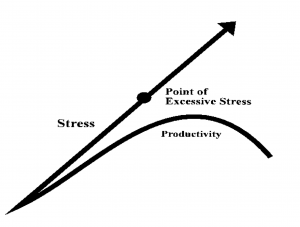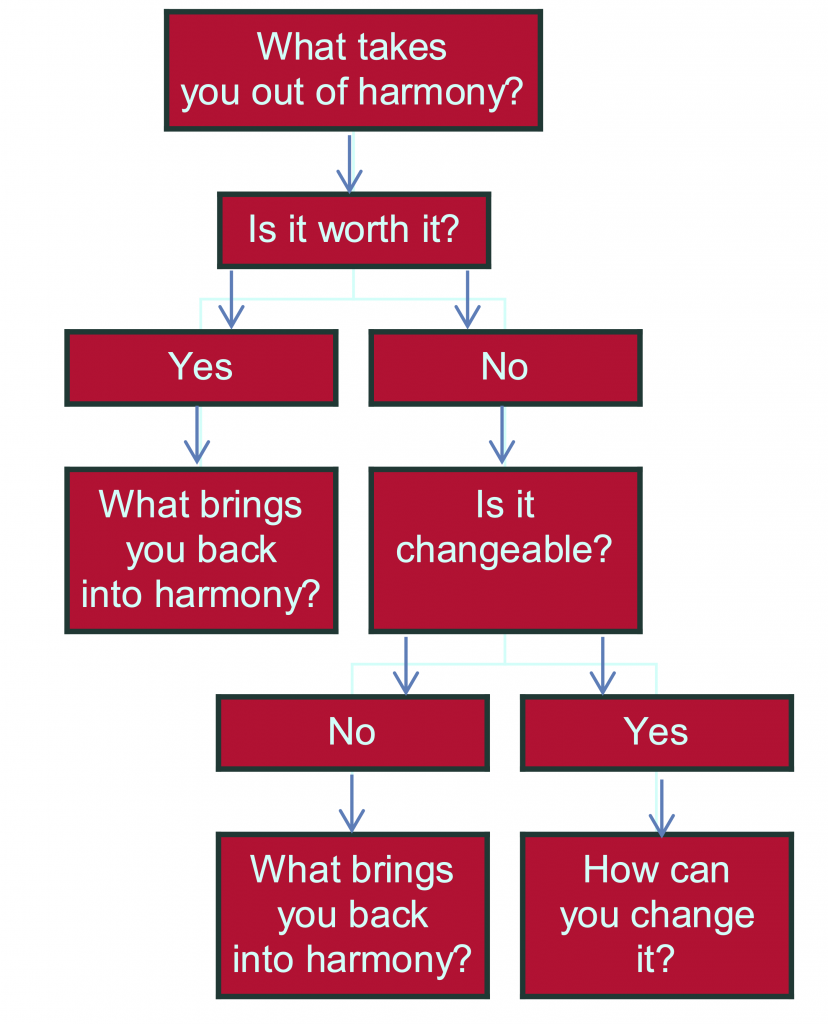1 Manage Personal Stress
Stress Identification
The simplest definition of stress is any response of the body to any demand. It is a dynamic state within an organism in response to a demand for adaptation. Stress is an unavoidable consequence of life. Without stress, we are dead. Distress can cause loss of productivity, disturbance in our personal lives, and even diseases. Fortunately, there are good stresses that offset this and promote wellness. Managing stress means gaining control over your life and dealing effectively with both the causes and the symptoms of stress.
What causes you stress?
List a few situations that you find stressful:
Types of Stress (based on the work of Hans Selye)
Understress – Lack of engagement with the events around us.
Eustress – This is also called positive stress. When our minds and bodies are in balance, we feel energetic, adaptable, approachable and relaxed.
Overstress – This is happening when we are tired, anxious, aggressive or defensive and is continual stress that causes us constantly to readjust elements of our lives. People have trouble returning to a balanced state when they are overstressed.
Distress – Distress is more extreme than overstress. It is a reaction to continual stress that leads to fatigue, exhaustion and physical and mental breakdown. This type of stress can lead to disease.
Other categories of stress include the following.
Cumulative Stress – This stress builds over time. Little things that in themselves do not seem particularly stressful add up. Cumulative stress may not show up for months, or even years.
Acute Stress – Acute stress may overwhelm a person’s usual coping ability such as being part of or witnessing a terrible accident (critical incident). This type of stress requires debriefing and / or counseling for effective recovery.
Delayed Stress (Post Traumatic Stress Disorder) – Stress reaction often does not show up at the time of a critical incident. It can surface at a later date, when you think that you have recovered from the initial stress.
Chronic Stress – When stress continues over time, it becomes chronic. Stress takes a toll on all aspects of life. We are likely to experience symptoms not only in our bodies, but also in our emotional reactions, our mental state, our relationships with others, our work world, and our spiritual life. It is important to define the symptoms of stress not only in a physical context. Some types of stress are considered to have a greater impact than others. Death of a family member is considered to be more stressful than a daily commute in rush hour traffic.
Symptoms of Stress
Check any symptoms of stress you have noticed lately in yourself.
|
Physical |
Emotional |
Spiritual |
Mental |
Relational |
|
appetite change headaches tension fatigue insomnia weight change colds muscle aches digestive upsets pounding heart accident prone teeth grinding skin rash restlessness foot tapping finger drumming increased alcohol, drug, or tobacco use |
anxiety frustration “the blues” mood swings bad temper nightmares crying spells irritability feeling that no one cares depression nervous laugh worrying easily discouraged little joy sadness |
emptiness loss of meaning doubt unforgiving martyrdom looking for magic loss of direction needing to prove self cynicism apathy |
forgetfulness dull senses poor concentration low productivity negative attitude confusion lethargy whirling mind no new ideas boredom spacing out negative self-talk |
isolation intolerance resentment loneliness lashing out hiding clamming up lowered sex drive nagging distrust fewer contacts with friends lack of intimacy using people |
Do you recognize any patterns in your stress symptoms? For instance:
- Is your mind working well (mental), but your body gets sick (physical)?
- Which symptoms are you most concerned about – relational, spiritual, or emotional ones?
- Are any areas of your life symptom-free?
- What else do you notice?
Building Stress Resistance
You are in charge of your lifestyle and make the final decisions about what you do as an individual. However, we receive many messages from within our family and from the wider world as we are growing up about whom we should be and how we are supposed to behave. In fact, when we become adults, we often forget where these messages were learned and simply hold them as beliefs. These messages tend to operate as ‘shoulds’ inside our head. This is called an internalized belief system.
These messages often come through as negatives that are criticizing us for our actions and choices. It is important however, to increase one’s awareness of what the messages are in order to better understand some of the sources of stress. Only then is it possible to have the distance to decide if the beliefs / messages are current or out of date. Then you can choose to adapt your internal beliefs to your current situation. When you hear that voice in your head being negative to yourself that is the time to turn the statement around into a positive one. This is a practice that takes time to develop.
Resistance to negative stress needs to be built up. Negative self-talk can drag us down while self-affirmations can help us to continue and succeed. We need to give ourselves space and time to adjust and develop coping strategies for stress.
This is a strong step to personal wellness. Good stress is energizing. In fact we all need positive stress to give us focus and drive. This action builds our stress resistance.
Stress Recovery
The common feeling of exhaustion often leaves many people unable to deal with the sources of stress in the complex personal, social and political environment in which we live. Coping strategies, such as avoiding stressful situations and turning negative self talk into positive message can help break this cycle and lets us regain some of our energy. As we regain energy, it becomes possible to look at what kinds of changes are needed. As we become stronger, we begin to do what we need to do to change the conditions that produce stress.
It is important to identify what activities are energizing for you. These may be work related, recreation, or family situations. They may include:
- Team activities (sports or work activities)
- Competition with others
- Competition against yourself (timed activities)
- Individual activities such as:
a) Cooking
b) Gardening
c) Walking, running, cycling
d) Crafts
e) Meditating
5. Volunteer activities in the community
6. Family activities with your own family and/or with others
7. Community activities such as:
a) Choir
b) Coaching
c) Tutoring
There are so many possible sources of positive stress enhancement that this is intended just to be a short list that might trigger some thoughts about what you do and can do to enhance your own positive energy. These types of activities help us to recover our energy and build distress resistance to the other situations around us.
Eustress Activity
Think back to a time when you felt really energized and well. List some activities that made you feel that way. How often do you do them?
Taking Control of Your Personal Stress
When we are stressed it brings with it fear and worry. Fear drives one to action. When there is no action, we have worry. Worry, or preoccupation, is intellectual as well as emotional. It tries to deal rationally but ineffectively with the situation that is causing us stress, however, the more you worry the worse it becomes. Worry consists of trying to occupy oneself about something before one can actually do something about it.
There is a rational positive and creative way to face worry, and fear. It consists in facing rationally the situation through six questions.
- What is the worst that can happen?
- Can you survive if it happens?
If you can’t survive, it is a real situation that you need to accept.
Once you have identified what you can survive, the next questions are:
- Can you do something to keep it from happening?
- If not, what can you do to minimize its impact?
- What can you do to rebuild things as good as before?
There is a sixth question that few people ask and that makes all the difference in the world to those who dare answer it:
- What can you do to make things even better than before?
Once you have answered these questions you are set to start acting. Once you start acting, preoccupation and worry are left behind.
If there is something you can do, do it. If there is nothing that you can do to minimize the impact of a situation, why worry? Concentrate on doing something useful while you are still alive. These steps are taken from Dale Carnegie’s book ‘How to stop worrying and start living’ (1948).
Returning to Harmony Activity:
The most useful thing in many situations to be keep your self-balanced and in harmony. Write out the answers to these questions.


